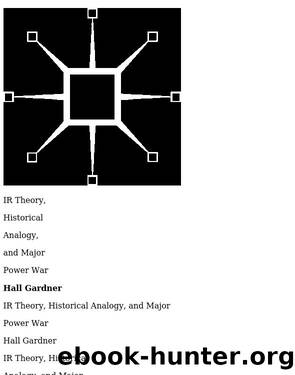3030046354 by Unknown

Author:Unknown
Language: eng
Format: epub
Published: 2018-12-20T10:22:22+00:00
168
H. GARDNER
the use of force on both geostrategic focal points, Berlin and Cuba.
Moscow was able to use both of these pressure points (deployments of
nuclear missiles in Cuba, coupled with threats to Berlin) as strategic lev-
erage intended to force the US to withdraw its nuclear weaponry from
Turkey and Italy. In contemporary circumstances, Moscow has similarly
been pressuring the US and NATO through its control over Kaliningrad
and Crimea today. As to be argued, although the option was not imple-
mented then, Kennan’s proposal to make a unified Germany “neutral”
appears to possess relevance with respect to Ukraine today (see Chapters
9 and 10).
west germany enters nato
In Europe, the formation of NATO in 1948–1949 as regional system of
defense was seen by Moscow as a means to potentially circumvent the
Soviet veto in the UN Security Council.6 The complex UN–NATO
interrelationship—in which NATO obtained its legitimacy from Article
51 of the UN Charter—would effectively permit the US and its allies to
act outside of the UN framework in situations of collective defense. At
the same time, the US and NATO needed to report to the UN Security
Council once hostilities began. From the US perspective, NATO would
provide defense against feared Soviet efforts to subvert or attack Western
Europe.
Given the fact that the US did not want to pay for European defenses
alone, Washington began to call for the re-militarization of West
Germany in 1950 in effort to counter Soviet military pressures after
the 1948–1949 Berlin crisis and at the time of the 1950–1953 Korean
War. This led to a debate, initiated by France, as to whether the US and
NATO—or a European Defense Community (EDC)—should over-
see European defenses. Yet the debate over the appropriate defense
role of West Germany in a new Europe resulted in checking the possi-
bility of forging the French-proposed EDC—as it was not clear whether
it would be possible to “contain” West Germany under an integrated
all-European defense command structure. Ironically, it was the French
Senate itself which vetoed French Prime Minister René Pleven plans
for the EDC—in fear that the proposal would create a super-national
force above the French national state, and that Germany might be given
undue influence in that body. (In post-Cold War circumstances, the con-
cept of the EDC has been proposed once again, but this time by France
7 FRACTURING OF THE COLLABORATIVE US–SOVIET … 169
and Germany, following the UK’s decision to exit the European Union.
In the past, the UK had generally opposed all-European defense propos-
als (see Chapter 10).
With the failure of proposals to establish an all-European defense
force (which were generally supported by Washington), NATO assumed
the primary role of “containing” the ambitions of Western Europe, while
also “containing” Moscow. This meant that Germany would need to be
integrated into NATO so that Bonn would not rearm. West Germany’s
later membership in NATO in 1955 then represented a unilateral means
by which the US/NATO had hoped to restrain West German military
capabilities and prevent Bonn from pursuing irredentist claims—if not to
develop nuclear weaponry.
Despite Soviet (and French) criticism of NATO, West German mem-
bership in NATO actually served the interests of both the Soviet Union
and France. NATO membership for West Germany helped to reassure
Moscow (and Paris) that West German
Download
This site does not store any files on its server. We only index and link to content provided by other sites. Please contact the content providers to delete copyright contents if any and email us, we'll remove relevant links or contents immediately.
Sita - Warrior of Mithila (Book 2 of the Ram Chandra Series) by Amish(51380)
The Crystal Crypt by Dick Philip K(35676)
Cat's cradle by Kurt Vonnegut(13855)
Always and Forever, Lara Jean by Jenny Han(13617)
Ready Player One by Cline Ernest(12828)
The Last by Hanna Jameson(9216)
Year One by Nora Roberts(8467)
Persepolis Rising by James S. A. Corey(8260)
The remains of the day by Kazuo Ishiguro(7541)
Dark Space: The Second Trilogy (Books 4-6) (Dark Space Trilogies Book 2) by Jasper T. Scott(7366)
Red Rising by Pierce Brown(7317)
Never let me go by Kazuo Ishiguro(7114)
The handmaid's tale by Margaret Atwood(6836)
The Circle by Dave Eggers(6248)
Legacy by Ellery Kane(5943)
The Testaments by Margaret Atwood(5771)
Frank Herbert's Dune Saga Collection: Books 1 - 6 by Frank Herbert(5592)
Pandemic (The Extinction Files Book 1) by A.G. Riddle(5584)
Six Wakes by Mur Lafferty(5192)
